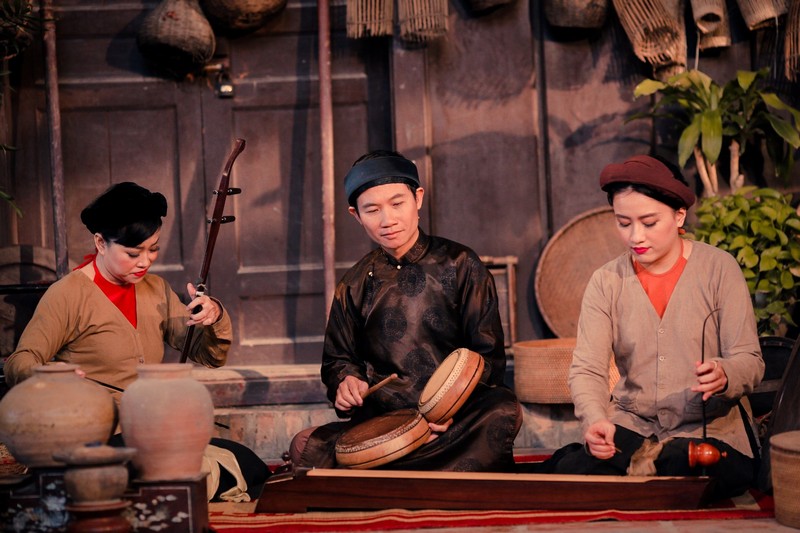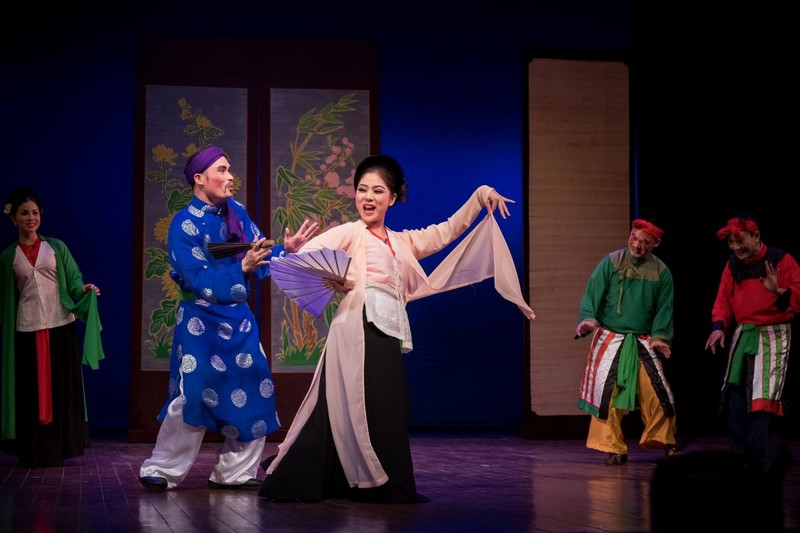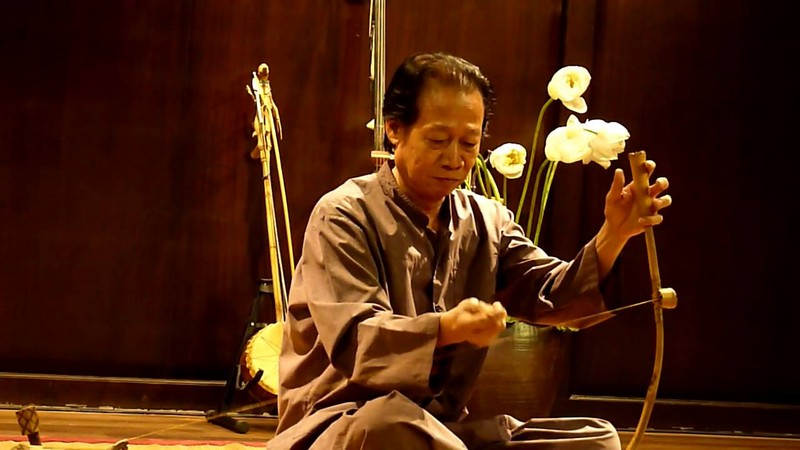“The Communal House is the cradle of culture, a place to keep spiritual memories and the history of the Vietnamese community alive, and where the traditions of Vietnam are still followed.”
[rpi]
The small auditorium of Le Space is dark and filled with many foreign audience members. The stage is quite simple, not all sparkles. The artists walk out calmly in dark clothes, not scrambling, waiting for their moment to play.

When the music begins, it immediately transports the soul of the Vietnamese festivals, with Cheo, Vi (free style singing), and Dam (poetry delivered in song) in the small communal house courtyard. It is boisterous and exciting. The room seems to quiet with the past memories of the communal house, and past fetivals rush back through the gongs, drumbeat, and virtuostic beats.
At the beginning of every spring, when the flowers are blooming, people usually gather in the communal house courtyard to enjoy the traditional festival with lively and lavish performances. As such, the communal house is also the place where people nurture and sustain Vienamese forklore that has been forgotten in the hustle and bustle of modern life.
Colourful life on the stage
The beauty and sophistication of folk art enable people to see a colourful life on stage, performed on a small and simple mat in the communal house. The front yard of a village’s Communal House, people can be amazed by the cheo’s paillard charater “Thi Mau” in a fun moment with her family’s servant “Anh No”.
With the exciting drumbeat, the stage at time becomes a joyous spring festival, and at times becomes a sorcerer who scares off ghosts. It’s ridiculous and humorous. In the same place, There is also a depicted large space where Ho Nguyet Co is struggling with the tragedy of her life. There is a character that is indispensable but no one take notice; it is called “ mass character”. The people sits as the background, play simple instruments, responds to the character, and juggles to make performances more charming. Sometimes the artist doesn’t need to pretend to be anyone at all; they just sing with reduplicative style and musical skills that make the audience feel like dancing to the sound of music.

“Music of Communal Houses” on Le Space’s stage presents slices of each folklore of Vietnam, but they are rich excerpts, expressing ecstactic moments of the artists. We can see personality, destiny, tragedy, and the mood and climax of the narrative performed by the most simple means.
Nurturing the Imagination
Folklore has an extremely powerful and magical language that allows it to present a narrative and stories of lives in a simple way on stage, with a language of body shape and convention.
To express themselves with this language, artists have to perform a high level of acting with no sound effects, light or modern skill. It is simply performed by movements of the hands, legs, facial expressions, and supported by several traditional instruments.
To study conventions of the traditional stage, we should look at Cheo and Tuong (classical dramas), especially a Tuong’s excerpt “Ho Nguyet Co Becomes the Fox” which is one of the most impressive. In the excerpt, she uses a whip to ride horses, chases the traitor to get back the pearl (which keeps her human), is startled upon seeing her reflection in the stream, and screams in pain seeing her body changes. Then, she is unable to communicate in human’s language and has to turn back into an animal.

People’s Artist Minh Gai makes audiences feel the sadness. The beauty of silk costumes also shine on the stage in this famous excerpt. Nguyet Co is shown as graceful when she is on the saddle, and when she struggles in her transformation from a human to a fox. The costume is comfortable, even for the stunts. After the performance, the endless applause seems to say that the traditional story still has value. People can imagine the actions, personalities and senses of the characters through this work. The play moves both artists and audiences to tears.
Music instruments – The Soul of Communal House Art
The sound first catches the attention of the people. Over time, these traditional sounds have become a highly refined art. Artist Xuan Hoach spent his lifetime discovering the sounds of national instruments. Since 1940, silk strings have completely disappeared because of the “expansion” of nylon and iron wire, which modernised traditional instruments. Even in Van Phuc Village, which once provided silk wire for most of theatres in Hanoi, silk wire is no longer made.
With the help of director Nhat Ly – who brought the contemporary play “My Village” to the stage – artisan Xuan Hoach began making silk into string once more. It’s a very difficult and arduous process. In 2010, he succeded and many artists came to know “the sound of silk,” as it is often called.
For Xuan Hoach, in formality, the most precious and unique of traditional instruments is the rustic one. It means that all factors that make an instrument must fit the Vietnamese style. He uses materials such as bamboo, wood, coconut shell, and dried gourd shells.
It is said that folklore is not a stagnant pond; it flows like a river. The destinies, the stories, and the personalities of the folklore still touches every modern citizens’ hearts. It flows silently, and enduringly nurtures the Vietnamese soul in its particular way.
Hong Nhung | Wanderlust Tips | Cinet

